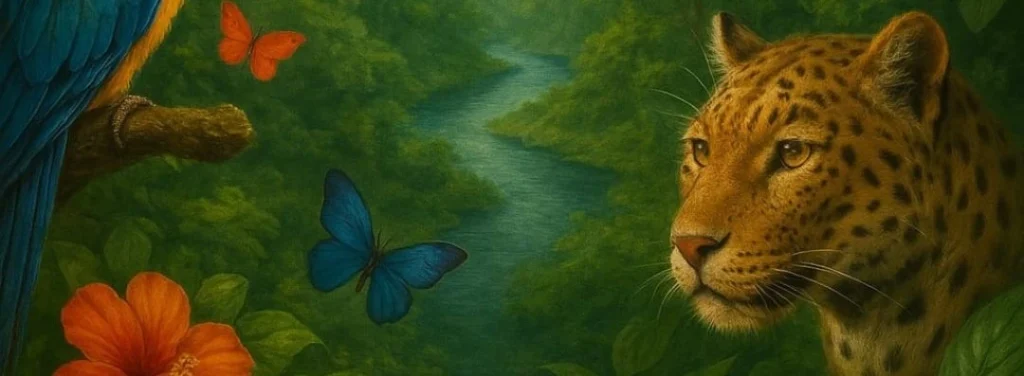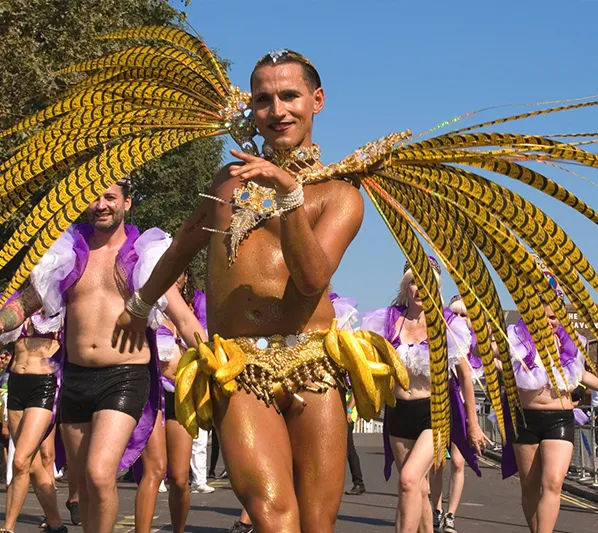Carnival
London School of Samba Performing at Notting Hill Carnival 2025
The largest Samba street parade outside of Brazil!
2025 Notting Hill Carnival
Riquezas e ameaças da Amazônia
Treasures and Threats of the Amazon
The Amazon, Earth's largest and most vital rainforest, stands at a crossroads — its ancient harmony threatened by modern demands, climate change, and relentless deforestation.
For Notting Hill Carnival 2025, the London School of Samba invites you to journey through the treasures and perils of the Amazon, asking whether humanity can rediscover balance with nature before the lungs of our planet are choked by smoke and loss.

Ala Animals Anfíbjos
Ala Animals Pássaro
Ala Flores
Would you like to join this ala?
This is Intermediate Level
Ala das Baianas
Ala Fogo
Ala Bateria

Breath in
The air that passes through your lungs is the air that flows through the lungs of the Earth.
The Amazon
Fuelled by Saharan dust, the forest is home to a million forms of life and a million more mysteries, all living together in harmony.
But that harmony is under threat. The Amazon holds untold treasures but is also under constant and significant threat. Medicines can be found under the canopy of the forest, but deforestation destroys the chances for humanity to benefit from their discovery. Multitudes benefit from the electricity generated from the power of the Amazon River, but generating the power disrupts its fragile ecosystem.
New harmony is required if man and nature are to survive together because the Amazon is more than just a South American forest; it is part of a global ecosystem that keeps the world alive because, as sambistas, we breathe in the air of the Amazon, and with every step of the foot and beat of the drum, the air of the Amazon fuels our hearts.
Unidos de Londres presents a story of the treasures and threats of the Amazon, which will go from the forest floor to the canopy above. In between, we will ask if balance can be restored or if we are doomed to suffer from unchecked avarice.

Amazonian Harmony and Dissonance
Everything lives in the harmonious cycle governing life, death and everything in between, from the forest floor to the canopy tops.
On the ground, the poison dart frog shoots between the legs of the jaguar, two predators regally hunting in their respective kingdoms. Deadly and beautiful, they seamlessly interact without ever coming in contact, for despite its size, the frog could kill the jaguar with just an errant touch.
Above the canopy, the hyacinth macaw, covered in its coveted blue feathers, patrols its territory, unwittingly avoiding the gaze of poachers.
On the river bank, the giant otter targets its prey, whether it’s fish or the caiman, safe in the fact that no one predator can take on the pack!
In the river, the most enchanting dolphin scans the water with its biosonar to find its next meal, but humans are put on alert because you never know if the Boto will entice you to a party that you may never leave.
These animals, amongst others, attempt to live in harmony, but they are all endangered. Threatened by the loss of their natural habitat. The ever-increasing need for beef decreases the amount of forest where these animals can live. Poachers hunt the otter for its pelt and the macaw for its feathers. Is there a way to balance the needs of the people versus the needs of the land?
Humanity, The Guardians and Raiders of the Forest
Humanity, at the top of the food chain, is ever present in the life cycle of the forest.
Over the past 11,000 years, tribes like the Yanomami, Guarani, and Awá were the first people to thrive in that great circle since time immemorial, carving out the first signs of humanity amongst the treasures and threats of the Amazon.
Those first people used the treasures of the Amazon in moderation to make their canoes, homes, and tools, emboldening their will to survive.
They were the first to cultivate the land, knowing that what the Amazon provides can also be taken away.
Over the centuries, others have entered the forest, some to learn, others to plunder. Explorers like Orellana navigated the great Amazon River looking for the Land of Cinnamon. The attack he suffered, by an army of women, led Europeans to give the river its mythological Greek name. The forest was unforgiving to newcomers like Fawcett, who disappeared looking for the Lost City of Z.
They both failed in their search for mythical lands and cities, leaving behind European religion and European illness to the unprotected Indigenous population.
More explorers, even presidents, traversed the river, but the indigenous people always suffered from modern expansion. Cândido Rondon changed that story by bringing modern technology through the great forest while demarcating a safe space for Indigenous to live.
The Amazon of today is not the Amazon of the past. Nearly half of the great forest has been lost to deforestation, mining, and grazing. Today, the Amazon is a mixture of the Indigenous and visitors, putting the sacred balance out of kilter, but there are signs of healing.
For every poacher looking for illegal gains or companies benefiting from illegal logging operations, groups in and outside the Brazilian Federal Government are working to protect the forest. Groups like the Instituto Arura Azul work to protect a single species like the Hyacinth Macaw, while large federal agencies like IBAMA work to protect the wider Amazonian environment.
For centuries, the Amazon was considered impenetrable, but in modern times, our technology has granted greater access to the forest’s treasures. Can we be responsible stewards of this delicate global treasure, or are we destined to be a threat to the forest?
Treasures for one, Treasures for all
The Amazon is delicate and unforgiving, pushing out those who do not seek to respect it. For tens of thousands of years, humans have learned to live in the forest in harmony with nature, but the modern drive for more “things” has pushed the forest to its limits. Is it possible to take resources from the forest without killing it? Can humanity live without the things we take from the forest?
The risks of the Amazon have changed. Rising global temperatures, decreasing biodiversity, and xenophobia have poisoned the great forest, but with threats come treasures.
Medicines developed from the forest’s riches that calm your nerves and soothe your skin. Food cultivated from the land brings joy to children and adults alike.
The great river is a highway for the ecosystem and the people who live upon it. The water can be as still as a mirror or as loud as an explosion.
Dams like the Tucurui generate power through the river’s force but at the cost of local people and native wildlife.
Mining for precious minerals under the forest floor destroys the habitats of both man and animal, but those minerals are key to creating clean energy like solar and wind power.
The treasures and threats of the Amazon are apparent, but is humanity mature enough to create a viable, harmonious solution or allow more smoke to choke the lungs of the Earth?
The London School of Samba will bring these questions to the streets and stages across London and Europe.
Exhale.

Ala Comunidade
Wear our exclusive Carnival 2025 t-shirt and celebrate as part of our community!
Sponsors & Partners
We are a self funded registered charity. If you can support us with in anyway, please get in touch.
Carnival Manager / Producer

Join us at Waterloo Action Centre For a dance or Drumming class or both!
Come and join us for a dance class on Sundays at Waterloo Action Centre or try out your Samba rhythm with Brazillian instruments (supplied) at a Sunday workshop. Not sure whether you’d prefer to dance or drum – you can try both on the same night! Please see the timetable for classes here.


